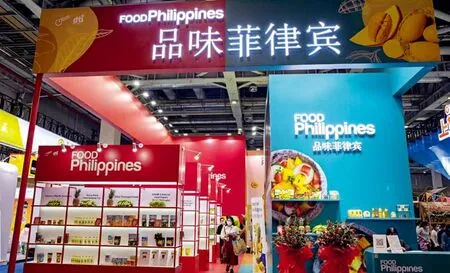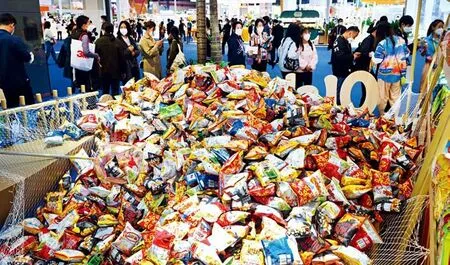An Appointment with CIIE Southeast Asian businesses have expressed confidence in the Chinese market
2023-01-18ByHuangJiangqin
By Huang Jiangqin
The Fifth China International Import Expo (CIIE) was held at the National Exhibition and Convention Center in Shanghai from November 5 to 10. Statistics from the organizer showed that as of 12 a.m. on November 10, a total of 461,000 people had attended the event and US$73.52 billion worth of tentative deals had been reached for one-year purchases, an increase of 3.9 percent over the previous edition.
Li Peiming, executive vice president of Liwayway (China) Co., Ltd., said that against the backdrop of the continuing COVID-19 pandemic, China has overcome great difficulties to organize this large-scale event.
The international trade fair featuring imported products has attracted massive participation with businesses from abroad seeing the great potential of the Chinese market. Having participated in the expo for five consecutive years, some Southeast Asian companies have become old friends of the CIIE.
A Platform for Opening-up
Liwayway, a snack food giant from the Philippines, brought its brand Oishi (known as Shanghaojia in China) to Shanghai decades ago, and the brand has since become a success across China. So far Oishi has participated in all five editions of the CIIE, and this year’s booth brought an island-style experience featuring such elements as camping tents and night fair on a tropical beach, which attracted many visitors. Walking on oceanic blue floors via electronic screens and surrounded by tropical fruits and coconut trees, visitors to the Oishi booth enjoyed taking pictures and playing various games.

The booth of Philippine products in the food and agricultural products exhibition area at the Fifth China International Import Expo in Shanghai, November 9, 2022. (VCG)
Over the last five years, Oishi’s booth area at the annual trade fair has increased from 36 square meters to 108 square meters. According to Li Peiming, the theme of the Oishi booth has varied at each CIIE. “Decorating this year’s booth with elements of a sunny beach, we wanted to present a Southeast Asian tropical island to visitors who have been unable to travel abroad due to the COVID-19 pandemic for the past three years,” said Li.
A 2022 report on China’s leisure snack industry showed that the Chinese snack market has maintained an annual compound growth rate of above 11 percent over the last seven years and that the market size is expected to exceed 1.5 trillion yuan (US$215.5 million) by the end of this year.
The growing Chinese market is attracting more and more companies from Southeast Asia.
In addition to large firms, CIIE has attracted participation from an increasing number of small and medium-sized enterprises (SMEs) year on year. With help from the Department of Trade and Industry of the Philippines, a total of 62 Philippine SMEs brought products to this year’s event. SMEs from the Philippines achieved sales of more than 100 million yuan (US$14.4 million) at the first CIIE in 2018 and four years later, the number increased to 600 million yuan (US$86.2 million)

Philippine snacks displayed at the Fifth China International Import Expo in Shanghai, November 7, 2022. (VCG)
Li applauded China’s determination to open its market wider as testified by the launch of CIIE. “While going global, China has also welcomed foreign investors with open arms to help its domestic market become better integrated with the global market,” Li noted.
Full Confidence in the Chinese Market
According to the China Import Food Industry Report 2022 released by the China Chamber of Commerce of Import & Export of Foodstuffs, Native Produce & Animal By-Products during this November’s CIIE, China imported US$135.46 billion of food products in 2021, a year-on-year increase of 24.5 percent, marking continuous rapid growth for a decade. Statistics showed that the annual compound growth rate of China’s food imports averaged 13 percent from 2012 to 2021 and that the number has passed 20 percent since the inception of the CIIE in 2018.
In the food and agricultural products exhibition area, Thai conglomerate Charoen Pokphand (CP) Group displayed about 110 products in six categories covering plant-based products, snacks, pet food, Thai sauces, frozen pork, and Japanese products.
“We have full confidence in the Chinese market and the buying power of Chinese consumers,” said Zhang Shuhui, senior president of CP Group Agroindustry and Food Business China Area. “The CP Group has attended the CIIE for five consecutive years because we have witnessed the leapfrog development of China’s economy as well as Chinese people’s growing willingness to spend and their pursuit of a higher quality of life.”
Zhang’s view was echoed by Tu Changming, director of the Public Affairs Department of Yihai Kerry Arawana Holdings, a leading food producer in China. After participating in all five editions of the CIIE, Tu better understands how China’s consumer market is constantly evolving. “With the market growing bigger and consumers getting more selective about what they buy, we have increased investment in product research and development,” he said. “We need a widely-recognized platform like the CIIE to present our products to Chinese customers and help them better understand our offerings.”
The central kitchen business of Arawana is gaining greater momentum in China after its first Central Kitchen Food Park started operation in Hangzhou this March. “Thanks to faceto-face interactions with local visitors and other exhibitors from various countries at the CIIE, we have gained clearer insight into consumer needs, which will play a vital role in product development and corporate planning,” added Tu.
Simpler Rules under RCEP
This year, businesses from all 14 other member countries of the Regional Comprehensive Economic Partnership (RCEP) participated in the CIIE. Since it came into force at the beginning of this year, the trade pact has produced increasingly rich dividends. According to data from China’s Ministry of Commerce, trade between China and the other 14 RCEP members reached 8.32 trillion yuan (US$1.2trillion) in the first eight months of 2022, accounting for 30.5 percent of China’s total foreign trade.
An important part of the CIIE in Shanghai, the Fifth Hongqiao International Economic Forum organized a high-level session themed “RCEP and Higher-level Opening-up.” In his speech via video during the session, Cambodian Deputy Prime Minister and Finance Minister Aun Porn Moniroth opined that the RCEP marks the most fruitful collaboration in regional opening-up in recent years by providing a comprehensive framework for regional trade and promoting the integration of regional supply chains into the global market. He believes that the trade agreement will inject strong impetus for achieving regional development vision and global prosperity.
“RCEP makes things simpler,” opined Zhang Shuhui. Under the agreement, tariffs on more than 90 percent of trade in goods in the region will eventually be lowered to zero. ASEAN Secretary-General Lim Jock Hoi said via video at the high-level session that the RCEP represents a pragmatic approach to overcoming multiple challenges confronting regional economic growth and that full implementation of the trade pact will help to foster intraregional investment, flow of capital, and trade in services.
According to an HSBC survey conducted for the fifth CIIE and released on November 6, 93 percent of responding companies from RCEP member countries, especially those from Indonesia, Vietnam, Malaysia, Thailand, and the Philippines, expect more trade with China due to the potentials of the RCEP.
杂志排行
China Report Asean的其它文章
- Capturing ‘Ghost Gear’Discarded fishing gear continues to “fish” as the ocean’s silent killer
- Ending Plastic Pollution
- Embracing The ‘Asian Moment’
- CELEBRATING THE 55TH ANNIVERSARY OF ASEAN China and ASEAN pursue common development through solidarity and mutual assistance
- CHINA’S NEW ECONOMY TAKES OFF The goal is to build a modern socialist economy with Chinese characteristics
- A Century of Chinese Animation Drawing a path with Chinese characteristics
